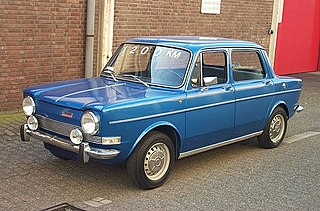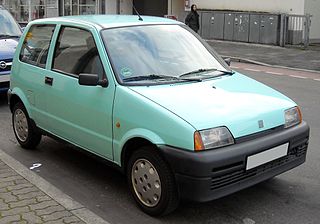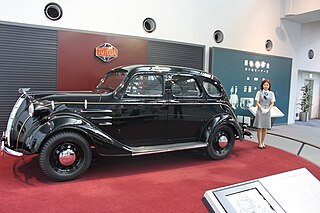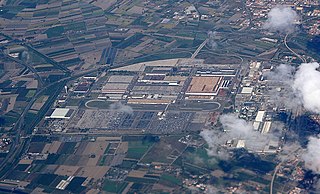
The Volkswagen Beetle—officially the Volkswagen Type 1, informally in German the Käfer, in parts of the English-speaking world the Bug, and known by many other nicknames in other languages—is a two-door, rear-engine economy car, intended for five occupants, that was manufactured and marketed by German automaker Volkswagen (VW) from 1938 until 2003.

Simca was a French automaker, founded in November 1934 by Fiat and directed from July 1935 to May 1963 by Italian Henri Pigozzi. Simca was affiliated with Fiat and, after Simca bought Ford's French activities, became increasingly controlled by the Chrysler Group. In 1970, Simca became a subsidiary and brand of Chrysler Europe, ending its period as an independent company. Simca disappeared in 1978, when Chrysler divested its European operations to another French automaker, PSA Peugeot Citroën. PSA replaced the Simca brand with Talbot after a short period when some models were badged as Simca-Talbots.

The Fiat 127 is a supermini car produced by Italian car manufacturer FIAT from 1971 to 1983. It was introduced in 1971 as the replacement for the Fiat 850. Production of the 127 in Italy ended in 1983 following the introduction of its replacement, the Fiat Uno, although the nameplate continued to be used on cars imported from Brazil.

The Fiat Uno is a front-engine, front-drive, four-passenger supermini manufactured and marketed by Fiat. Launched in 1983, the Uno was produced over a single generation in three and five-door hatchback body styles until 1995 in Europe — and until 2013, in Brazil. Designed by Giorgetto Giugiaro of Italdesign, the Uno strongly recalled the high-roof, up-right packaging of Giugiaro's 1978 Lancia Megagamma concept, in a smaller configuration.

The Fiat 500 is a rear-engined, four-seat, small city car that was manufactured and marketed by Fiat Automobiles from 1957 to 1975 over a single generation in two-door saloon and two-door station wagon bodystyles.

The Fiat 126 is a four passenger, rear-engined city car that was introduced by Fiat in October 1972 at the Turin Auto Show as a replacement for the Fiat 500. The majority of 126s were produced in Bielsko-Biała, Poland, as the Polski Fiat 126p, where production continued until 2000. In many markets Fiat stopped sales of the 126 in 1993 in favour of their new front-engined Cinquecento. Total production reached almost 4.7 million units.

The Fiat Tipo is a compact car, designed by the I.DE.A Institute design house, and produced by the Italian manufacturer Fiat between 1988 and 1995.

The Pratt & Whitney R-2800 Double Wasp is an American twin-row, 18-cylinder, air-cooled radial aircraft engine with a displacement of 2,800 cubic inches (46 L), and is part of the long-lived Wasp family of engines.

The Fiat Cinquecento is a front engine front-wheel-drive, four passenger, three door hatchback city car, manufactured and marketed by Fiat from 1991–1998 over a single generation.

Unic was a French manufacturer founded in 1905, and active as an automobile producer until July 1938. After this the company continued to produce commercial vehicles, retaining its independence for a further fourteen years before being purchased in 1952 by Henri Pigozzi, who was keen to develop Unic as a commercial vehicle arm of the then flourishing Simca business.
Economy car is a term mostly used in the United States for cars designed for low-cost purchase and operation. Typical economy cars are small, lightweight, and inexpensive to both produce and purchase. Stringent design constraints generally force economy car manufactures to be inventive. Many innovations in automobile design were originally developed for economy cars, such as the Ford Model T and the Austin Mini.

The Fiat 1100 is a small family car produced from 1953 to 1969 by the Italian manufacturer Fiat. It was an all-new unibody replacement for the Fiat 1100 E, which descended from the pre-war, body-on-frame Fiat 508 C Balilla 1100. The 1100 was changed steadily and gradually until being replaced by the new Fiat 128 in 1969. There were also a series of light commercial versions of the 1100 built, with later models called the Fiat 1100T, which remained in production until 1971. The Fiat 1100 D also found a long life in India, where Premier Automobiles continued to build the car until the end of 2000.

The Studebaker US6 (G630) was a series of 2 1⁄2-ton 6×6 and 5-ton 6×4 trucks manufactured by the Studebaker Corporation and REO Motor Car Company during World War II. The basic cargo version was designed to transport a 5,000 lb (2,300 kg) cargo load over any type of terrain in any weather. Most of these were exported to the Soviet Union under Lend-Lease by the USA during World War II, since the competing GMC 6×6 CCKW design proved to be more suitable for Western Front conditions.

The 508 Balilla was a compact car designed and developed by Fiat in 1932. It was, effectively, the replacement of the Fiat 509, although production of the earlier model had ceased back in 1929. It had a three-speed transmission, seated four, and had a top speed of about 50 mph (80 km/h). It sold for 10,800 lire. About 113,000 were produced.

Dante Giacosa was an Italian automobile designer and engineer responsible for a range of Italian automobile designs — and for refining the front-wheel drive layout to an industry-standard configuration.

The A1 was the first prototype passenger car built by the company that became Toyota. It was redesigned and put into production as Toyota's first production cars, the AA sedan and the AB cabriolet. These were succeeded by the similar AE, AC and BA sedans.

The Fiat 1500 was a six-cylinder car produced by the Fiat from 1935 to 1950. It was one of the first cars tested in a wind tunnel, following the Chrysler Airflow produced one year earlier. The streamlined styling achieved an aerodynamic efficiency unequalled before it in a touring car and disproved the thesis aerodynamic cars would not sell.

Fiat Automobiles S.p.A. is an Italian automobile manufacturer, a subsidiary of Stellantis. Fiat Automobiles was formed in January 2007 when Fiat S.p.A. reorganized its automobile business, and traces its history back to 1899 when the first Fiat automobile, the Fiat 4 HP, was produced.

In 2015 Spain produced 2.7 million cars which made it the 8th largest automobile producer country in the world and the 2nd largest car manufacturer in Europe after Germany. The forecast as of 2016 was to produce a total of 2.8 million vehicles from which about 80% is for export. During the first half of 2016, with exports valued over 24,000 million euros over that period, the automotive industry accounted for 18.9% of the total Spanish exports.

The Alfa Romeo Pomigliano d'Arco plant, commonly called simply Stellantis Pomigliano, is an automotive assembly plant now owned by Stellantis, officially known as the Giambattista Vico Plant since 2008, in memory of the Neapolitan philosopher. The plant, originally designed and constructed in 1968 by Alfa Romeo, is located largely in the town of Pomigliano d'Arco, and partially in the town of Acerra. The plant currently employs roughly 6,000 employees.




















